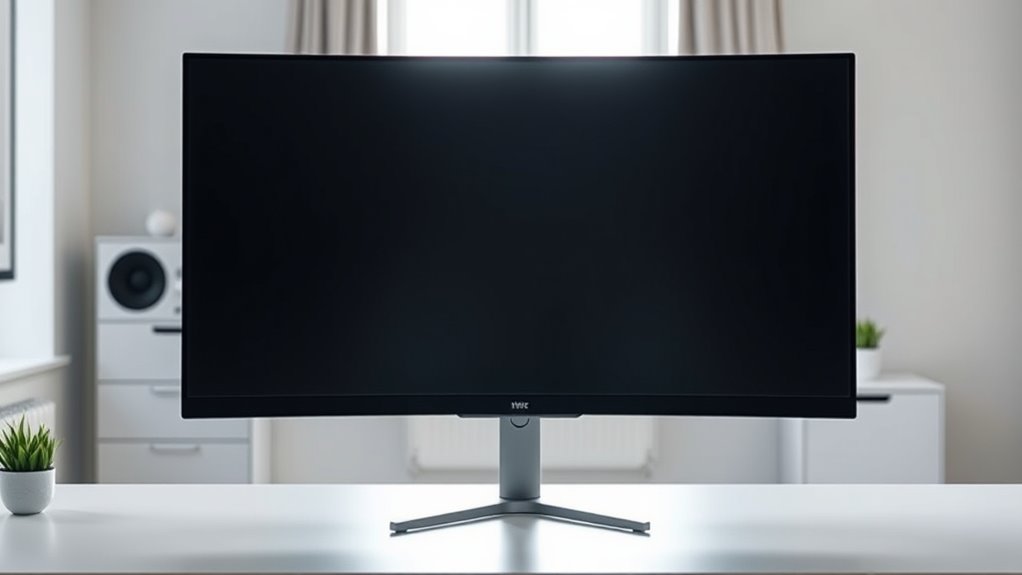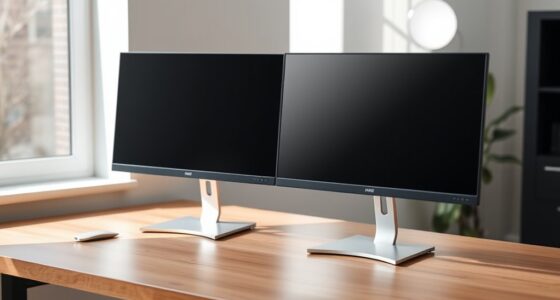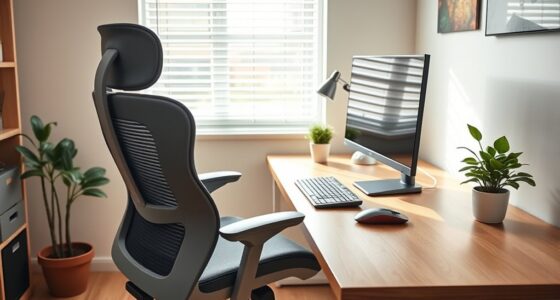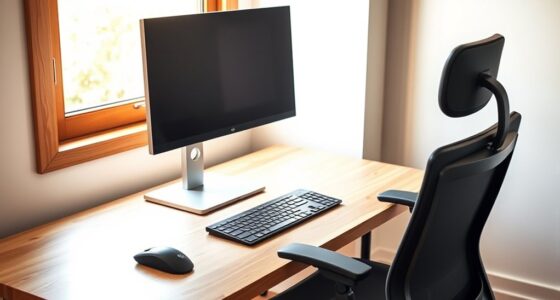To protect your eyes, position your monitor directly in front of you at about an arm’s length away, with the top at or just below eye level. Tilt the screen slightly upward to reduce glare, and use soft, evenly distributed lighting while avoiding direct bright lights. Adjust the monitor’s height and angle for comfort, and take regular breaks to look at distant objects. Keep exploring these tips for a healthier, more comfortable workspace.
Key Takeaways
- Position your monitor directly in front at an arm’s length to reduce eye strain and maintain proper posture.
- Keep the top of the screen at or slightly below eye level for comfortable viewing angles.
- Tilt the monitor slightly upward to minimize glare and reflections that can cause eye fatigue.
- Arrange workspace lighting to be soft and evenly distributed, avoiding direct bright light on the screen.
- Take regular breaks every 20 minutes, focusing on distant objects to relax eye muscles.

Are you unsure where to place your monitor for maximum comfort and productivity? The right placement is essential for maintaining an ergonomic posture and preventing eye strain. When your monitor is set up correctly, you’ll find it easier to work for longer periods without discomfort or fatigue. Start by positioning your monitor directly in front of you, about an arm’s length away. This distance helps keep your eyes focused comfortably and reduces the need to lean forward or backward, which can strain your neck and shoulders. Keep the top of your screen at or slightly below eye level so that you don’t have to tilt your head up or down. This positioning encourages a natural head and neck alignment, supporting ergonomic posture and lessening the risk of neck pain over time.
Adjusting your monitor’s tilt is equally important. Tilt the screen slightly upward so that the glare and reflections are minimized, but avoid tilting it excessively, which can cause you to crane your neck or misalign your posture. The goal is to have a smooth, natural angle that feels comfortable during extended work sessions. Proper monitor placement also involves reducing glare from windows or overhead lights. Position your monitor perpendicular to windows when possible, or use blinds and curtains to control light. Anti-glare screens or matte finishes can also help prevent eye strain caused by harsh reflections. Additionally, choosing a monitor with ergonomic features like height adjustment can greatly enhance your setup.
Lighting plays a key role in eye comfort. Ensure your workspace is well-lit, but avoid direct bright light shining on your screen or your eyes. Soft, evenly distributed lighting reduces contrast and minimizes eye fatigue. Take breaks regularly—every 20 minutes, look away from your screen and focus on distant objects for at least 20 seconds. This simple habit helps relax your eye muscles and prevents strain. Keep your workspace clutter-free to avoid unnecessary distractions that can cause you to adopt awkward postures, which compound the risk of discomfort.
Lastly, consider the overall ergonomics of your workstation. Use an adjustable chair that supports your lower back and promotes a relaxed, upright sitting position. Your feet should rest flat on the floor, with your knees at about a 90-degree angle. When your monitor is positioned correctly, you’ll naturally adopt a better posture, which benefits your eyes and your entire body. Proper monitor placement isn’t just about comfort; it’s an essential step in preventing long-term strain and ensuring you stay focused and productive throughout your workday.
Frequently Asked Questions
How Often Should I Adjust My Monitor Position?
You should adjust your monitor position whenever you notice discomfort, eye strain, or changes in your posture. Regularly reviewing your setup guarantees it stays ergonomic. Use ergonomic accessories like adjustable mounts to make quick, frequent adjustments easy. Ideally, check your monitor alignment every few weeks to maintain proper eye level and distance. Staying proactive helps prevent strain and keeps your workspace comfortable and healthy.
What Are Signs My Monitor Is Causing Eye Strain?
Your eyes might be signaling trouble like a warning light if you notice dryness, irritation, or blurred vision after hours at your screen. You could also experience headaches or neck pain. These signs indicate your monitor may be causing eye strain. To help, use ergonomic accessories, take regular breaks, and do eye exercise routines. Staying attentive to these cues keeps your eyes healthy and your work comfortable.
Can Monitor Placement Affect Overall Productivity?
Monitor placement greatly impacts your productivity by promoting ergonomic posture and reducing strain. When your screen is correctly positioned, you’re less likely to develop discomfort or fatigue, allowing you to focus better. Make sure your monitor is at eye level and avoid glare from ambient lighting. Proper placement helps maintain comfort, keeps you alert, and boosts efficiency, making your workday smoother and more effective.
Are There Specific Screen Settings for Eye Comfort?
To enhance eye comfort, you should adjust screen brightness so it matches your environment—neither too bright nor too dim. Set a comfortable font size that’s easy to read without straining your eyes. You can also enable blue light filters or use night mode during late hours. These settings help reduce eye fatigue, making your screen time more comfortable and less tiring, ultimately supporting your productivity and eye health.
How Does Monitor Size Influence Placement Rules?
Oh, the grand mystery of monitor size and placement—because bigger screens automatically mean better ergonomics, right? Not quite. You should consider monitor ergonomics by adjusting your screen size and position so your eyes aren’t strained. Larger screens may need to be placed further away, while smaller ones can sit closer. Keep your monitor at eye level, regardless of size, to prevent neck and eye strain, making your workspace both safer and more comfortable.
Conclusion
By following these monitor placement rules, you create a cozy oasis for your eyes—a gentle sanctuary where the screen’s glow doesn’t strain or overwhelm. Imagine your monitor as a calm lighthouse, guiding your vision safely across the sea of work. When you position it just right, your eyes can rest easily, like a traveler finding peace after a long journey. Protect your sight today, and enjoy clearer, more comfortable viewing every day.









